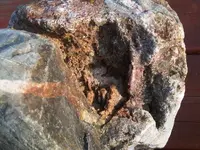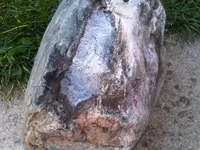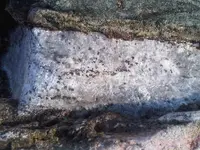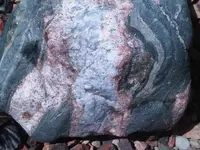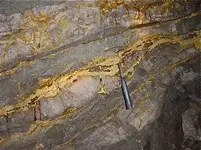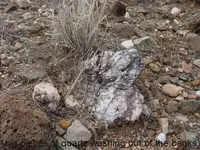Klondike here...
Without actually seeing the samples... it is difficult at best to determine just what you do have there...in these pictures..
KEEP IN MIND THAT GOLD IS FOUND..."WHERE YOU FIND IT..."..... now and then gold tricks us and it is found in very odd places...and sometimes "breaks" all the rules... lol
But usually, the quartz is softer than the host rock.... and almost always found on a contact of two different types of rock structures...
I do not SEE softer quartz and nor do I see different rock contacts... Please understand, just because there are two different colored rocks on each size of a quarts vein, doesn't always mean these two different rocks are different and forming a contact, ....but often the same rock structure can come in many different colors, depending on the temperature, age, pressure, heat and possible minerals present...when it was formed...
Quarts can be formed in either cold water or hot water..... It is very, very, very, very rare for gold to found in quarts formed by cold water...... Gold is almost always found in quartz that was injected into the contact zone when it was hot, by geothermal processes...
The pictures seem to have some clear and defined "crystals" of quartz, albeit.. very small crystals, but crystals none the less...which is almost always associated with cold water quarts... The larger quartz crystal we have all seen at other times , were formed by cold water...
Hot water quartz has less crystals and cuts and polishes very easily... it seems to me the samples in the pictures would crumble, due to there crystalline structure when being cut, not allowing for a good polish...
Below is a pic of some quarts in a gold rich alluvial deposit... notice the difference in the quarts structures between the pic below and the samples in original post...BTW.. the quartz pictured below, is known for it's high gold values..... also, notice the smaller pieces of quartz scattered about and around the largest piece of quartz... notice the texture compared to the original post pictures.... this is the kind of quartz that gold is usually found in...
But remember, gold is where you find it... soooooo crush some of the rocks and quartz and pan it out... or best thing, have it assayed.. it only takes about 3 or 4 ounces of a sample for a good assay...then you'll know the real truth behind what you have..
Hope this helps...and good job.. keep looking who knows you may have something really good there...
Klondike....



